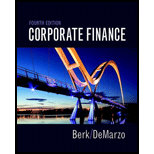
Explain what is wrong with the following argument: “If a firm issues debt that is risk free, because there is no possibility of default, the risk of the firm’s equity does not change. Therefore, risk-free debt allows the firm to get the benefit of a low cost of capital of debt without raising its cost of capital of equity.”
Want to see the full answer?
Check out a sample textbook solution
Chapter 14 Solutions
Corporate Finance (4th Edition) (Pearson Series in Finance) - Standalone book
Additional Business Textbook Solutions
Accounting Information Systems (14th Edition)
Horngren's Cost Accounting: A Managerial Emphasis (16th Edition)
Financial Accounting: Tools for Business Decision Making, 8th Edition
Horngren's Financial & Managerial Accounting, The Financial Chapters (Book & Access Card)
Financial Accounting, Student Value Edition (5th Edition)
Financial Accounting (12th Edition) (What's New in Accounting)
- Don't used Ai solutionarrow_forwardAssume an investor deposits $116,000 in a professionally managed account. One year later, the account has grown in value to $136,000 and the investor withdraws $43,000. At the end of the second year, the account value is $107,000. No other additions or withdrawals were made. During the same two years, the risk-free rate remained constant at 3.94 percent and a relevant benchmark earned 9.58 percent the first year and 6.00 percent the second. Calculate geometric average of holding period returns over two years. (You need to calculate IRR of cash flows over two years.) Round the answer to two decimals in percentage form.arrow_forwardPlease help with these questions.arrow_forward
- Please help with these questionsarrow_forwardIn 1895, the first U.S. Putting Green Championship was held. The winner's prize money was $170. In 2022, the winner's check was $3,950,000. a. What was the percentage increase per year in the winner's check over this period? Note: Do not round intermediate calculations and enter your answer as a percent rounded to 2 decimal places, e.g., 32.16. b. If the winner's prize increases at the same rate, what will it be in 2053? Note: Do not round intermediate calculations and enter your answer as a percent rounded to 2 decimal places, e.g., 32.16. a. Increase per year b. Winners prize in 2053 %arrow_forwardDerek plans to retire on his 65th birthday. However, he plans to work part-time until he turns 73.00. During these years of part-time work, he will neither make deposits to nor take withdrawals from his retirement account. Exactly one year after the day he turns 73.0 when he fully retires, he will begin to make annual withdrawals of $183,008.00 from his retirement account until he turns 94.00. After this final withdrawal, he wants $1.52 million remaining in his account. He he will make contributions to his retirement account from his 26th birthday to his 65th birthday. To reach his goal, what must the contributions be? Assume a 6.00% interest rate. Round to 2 decimal places.arrow_forward
- Derek plans to retire on his 65th birthday. However, he plans to work part-time until he turns 71.00. During these years of part-time work, he will neither make deposits to nor take withdrawals from his retirement account. Exactly one year after the day he turns 71.0 when he fully retires, he will begin to make annual withdrawals of $177,333.00 from his retirement account until he turns 94.00. He he will make contributions to his retirement account from his 26th birthday to his 65th birthday. To reach his goal, what must the contributions be? Assume a 9.00% interest rate. Submit Answer format: Currency: Round to: 2 decimal places.arrow_forwardDerek plans to retire on his 65th birthday. However, he plans to work part-time until he turns 72.00. During these years of part-time work, he will neither make deposits to nor take withdrawals from his retirement account. Exactly one year after the day he turns 72.0 when he fully retires, he will wants to have $3,104,476.00 in his retirement account. He he will make contributions to his retirement account from his 26th birthday to his 65th birthday. To reach his goal, what must the contributions be? Assume a 8.00% interest rate. Submit Answer format: Currency: Round to: 2 decimal places.arrow_forwardBanking and finance sector ma job kaise payearrow_forward
 EBK CONTEMPORARY FINANCIAL MANAGEMENTFinanceISBN:9781337514835Author:MOYERPublisher:CENGAGE LEARNING - CONSIGNMENT
EBK CONTEMPORARY FINANCIAL MANAGEMENTFinanceISBN:9781337514835Author:MOYERPublisher:CENGAGE LEARNING - CONSIGNMENT Intermediate Financial Management (MindTap Course...FinanceISBN:9781337395083Author:Eugene F. Brigham, Phillip R. DavesPublisher:Cengage Learning
Intermediate Financial Management (MindTap Course...FinanceISBN:9781337395083Author:Eugene F. Brigham, Phillip R. DavesPublisher:Cengage Learning

